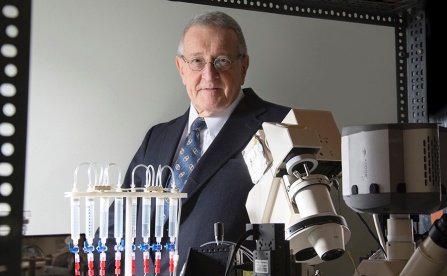Dr. Weeks’ Comment: Stress, with its negative connotation and anxiety (its emotional corollary) is oft times blamed for human dis-stress and dis-ease. This, however, is not a fair assertion. No one “has” anxiety forced upon them. In fact, people experience simply an adrenaline feelings and then, perhaps mostly by habits of thought, people put either a negative or a positive cognitive spin on that biochemical flood rendering the experience either stressful or exhilarating.
Now we see that ordinary cells too, when “stressed”, can transcend their circumstances and become the totipotent hematopoietic stem cell! How nice a reminder of the health and well-being which slumbers within us all!

Frederick Sachs, PhD, and his team found that changing cell mechanics turns normal cell types into spherical cell clusters with many of the biochemical markers of stem cells.
Mechanical Stress Produces ”˜Stem-Like’ Cells Via Nontoxic Method
Published January 9, 2015
Using mechanical stress, scientists at the University at Buffalo and colleagues have turned normal cells into ”˜stem-like’ cells, suggesting a possible safe, new way to produce stem cells.
Method Negates Need for Transcription Factors
In tissue culture, the researchers changed the mechanical stresses on neuronal and other cell types. Doing so reprogrammed these immortalized, or model, cells into cells with many of the biochemical markers of stem cells.
“The possibility that we may be able to obtain stem cells simply by altering cell mechanics could bring stem cell therapy closer to the clinic,” says senior co-author Frederick Sachs, PhD, SUNY Distinguished Professor of physiology and biophysics.
Stem cells have the potential to differentiate into any type of cell in the body, regenerating and repairing damaged tissue.
However, their clinical application has been held up, in part, by the need to use chemical transcription factors that can be toxic, Sachs explains.
The mechanical process negates the need for transcription factors, though further research is needed to determine if cells reprogrammed this way can differentiate, Sachs notes.
UB-Invented Probe Measures Mechanical Stress
The research was made possible by a genetically encoded optical probe invented by lead UB co-author Fanje Meng, PhD, a research scientist in physiology and biophysics. Meng earned his doctorate in biophysics at UB, studying under Sachs.
“This probe allows us, for the first time, to measure the stress in actin within living cells,” explains Sachs.
Actin, a key structural protein in cells, is involved in numerous cellular processes ”” including cell signaling, shape and movement ”” as well as muscle contraction.
The actin probes provide key information ”” in real time ”” about how mechanical forces influence living cells, tissues, organs and animals.
Tension in Actin Fibers Higher in Stem Cells
In a finding Sachs describes as “very surprising,” the actin stress probe showed that the tension in actin fibers in stem cells is higher than in normal cells.
“We saw gradients of stress in actin filaments even in single living cells,” says Sachs.
“Much of existing biomechanics will have to be rethought, since many studies have assumed that the stresses are uniform.”
Probe May Increase Understanding of Metastasis
Mechanical forces are known to play a role in cellular processes. For example, metastatic cancer cells have different mechanics than cells of the parent tumor.
Yet, the details are poorly understood, Sachs notes, because there have been few ways to measure the stress in specific proteins.
As a measuring tool for this purpose, the probe will have broad biological applications.
“With this invention, cancer researchers can better understand what allows cells to become metastatic,” says Sachs.
By creating transgenic worms and flies that express the probes, the researchers also have demonstrated that their method is not toxic to cells ”” and, therefore, can be safely used to study whole animals.

